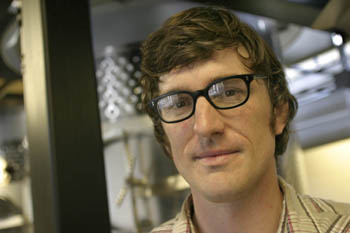
Guatemala RPCV Ames Morison creates sustainable vineyard
How Does Your Vineyard Grow?
Medlock Ames and the making of a winery
By Heather Irwin
Caption: New Breed: Vintner Ames Morison, shown here, works with partner Christopher Medlock James to create a more sustainable product. Photograph by Rory McNamara
Winding down a desolate dirt road for more than a mile, it suddenly becomes clear that I've taken a wrong turn somewhere. Though I'd expected to scramble through brush and bramble in search of Ames Morison's Chalk Hill winery, I'm definitely lost. Plus I'm a half-hour late, stuck on what is less a road than a convergence of dirt, gravel and potholes.
Suddenly, the makeshift road ends--actually stops dead--at the edge of a vineyard that sways greenly for acres below. Sliding to a gravelly stop, I've nearly pitched headlong down the hillside toward a grapey demise. But as the kicked-up dust continues to silently swirl around me, I peer across the valley, awestruck by row after row of Morison's perfectly ordered green vines. Nature, briefly tamed.
Driving through wine country day after day, the beauty so often becomes routine. Whizzing past the trellises at 55 mph, it's often a vegetative blur. But having bits of fence and leaves pressing against your bumper tends to bring it all into sharp focus. At the back door of this fledgling winery, I'm abruptly reminded to stop and smell the grapes for a moment and enjoy. Sniff. Ah. OK. Done.
And with a spin of tires and rock, I head back over the gravel and through the potholes, back to the main road and what I'm praying is the right entrance this time.
Sprawled out over 188 acres at the far southwest corner of Alexander Valley, Medlock Ames, co-owned by hipster thirty-somethings Ames Morison and Christopher Medlock James, has been quietly getting off the ground for the last two years. Nestled in the Alexander Valley appellation, the winery has only recently released its 1999 and 2000 Merlots, having sold grapes to other wineries and focused on the whole business of getting started. Not a bad neighborhood for two guys who, eight years ago, didn't know much more about wine than what was in their glass.
The story goes that the two former Tulane University roommates had a crazy idea somewhere around 1996 while quaffing a bottle of Talbott Diamond T Chardonnay. Let's start a winery, they said. James, who had earned a small fortune in technology, would be in charge of the capital. Morison would run the day-to-day operations. Though a history major, he had grown up on a farm and had recently returned from a Peace Corps stint in Guatemala teaching highland farmers back-to-the-earth farming methods forgotten during disastrous modernization efforts.
It appeared, too, that a few years of viticulture study at UC Davis loomed in his future. As to cost, Morison will only affirm that "building a winery is very capital-intensive."
But where the story differs from so many others in the valley is in the youthful sensibility that James and Morison bring to the table. Unabashedly as comfortable with indie rock as with the ins and outs of malolactic fermentation, they have created the winery from the ground up according to their own unique personalities and ambitions.
That's obvious in the design of the winery. Bordered all around by bamboolike horsetail grass shooting skyward from the ground, it is all sleek angles and contemporary lines. Sitting low on the horizon, the stone and wood are bordered by a thin band of dark glass that allows Morison and his workers to take advantage of natural sunlight. Half of one side, facing the parking lot, is open steel and glass, Morison explains, "to give us beautiful views while we're working."
In a thrift-store cowboy shirt and Elvis Costello glasses, Morison seems to be more of an urbanite's ironic interpretation of a farmer than an actual farmer, though his caked and dusty work boots suggest otherwise. Touring the winery and vineyard, he is totally at ease on the property, as we wander through the vines he's planted here over the last several years.
"What I enjoy most about what I do is the process," he says. "I love getting up early in the morning to harvest. I love getting my hands stained black with tannin. I love the people I work with. There are so many minor frustrations and things that don't go my way and a few major ones, and even some sleepless nights when I worry about frost or a stuck fermentation, but I love it all."
Like the rather new viticulturalist that he is, Morison is all about the process of agriculture, though you don't get the sense that he's spending a whole lot of time consulting The Farmer's Almanac or walking around with divining rods. These days it's about chemistry and lab results. In fact, the winery has its own small lab inside, filled with beakers and strange tubes, where Morison seems especially comfortable.
What's ironic, however, is that this new generation of science- and technology-friendly vintners also looks back--way back--for much of its inspiration. For instance, Morison is thoroughly committed not only to organic farming, but biodynamic farming. Biodynamic practices incorporate whole-earth techniques that take into account water, land and animal populations as part of the agricultural practice, rather than just avoiding certain harmful pesticides. Having seen the devastating impact of years of poor agriculture practices during his stint in the Peace Corps, Morison is convinced that respect for the land is not just a faddish notion or a publicity stunt, but a sound, long-term philosophy.
"There are hundreds of wineries in California. I feel strongly that our wines are distinctive, and that we are doing something unique by creating a completely sustainable operation that is organic with a broad diversity of plant and animal life," he says. This is the type of farming practiced by our grandparents and their grandparents. Soon, the winery will also be fully solar-powered.
With a wildlife preserve neighboring the vineyard, Morison has purposefully left nearly two-thirds of the total property in its natural state. He plans to create a land bridge across the vineyards for animals traveling to and from the preserve. That would make at least one puppy happy. Portions of the land, according to Ames, once belonged to "Peanuts" artist Charles Schulz, and Ames claims to have found on the property a dilapidated old doghouse that closely resembled Snoopy's.
Additionally, this year, nearly 20 acres of Sauvignon Blanc vines were replanted to be more disease-resistant, as well, Morison says, as "some Cabernet Franc and Petit Verdot to blend with our Bordeaux-style blend." Pointing to the various lots, he is a new breed of farmer who thinks as much about the future of his land as he does the present. Right now, he says they are thinning the crop to eliminate unripe grapes that add a bitter flavor and will begin harvesting their Merlot grapes at the end of August, the earliest they've been picked in the vineyard.
But planting grapes and making wine is one thing; distribution, the biggest challenge of any winery, particularly a small boutique operation like Medlock Ames, is quite another. The two vintners have crossed their fingers and sent their Bourdeaux-informed product both to the prestigious Wine Spectator magazine for review and to the dean of all appraisers, Robert Parker.
"Stellar reviews," Morison admits, aren't the "most likely scenario," given the number of hopeful souls who submit their wines to both Parker and the Spectator each year. "Even still," Morison says, "we would not be profitable for four years. Our other forecasts, requiring us to rely more heavily on distributors, which offer us the lowest margin, push the profitability out further. It all depends on getting our name out there--and, of course, on the quality of the wine."
The two are counting on their website (www.medlockames.com) to act as their primary distribution arm, hoping that those who've tasted their products at specialty shows will join their wine-club list. Brix and Ravenous restaurants both pour Medlock Ames; a small specialty shop in Yountville carries the wine; and the two just signed a distribution deal with brokers in both Southern and Northern California.
"We are trying to target people like us," Morison says, "young, forward-thinking, and if not committed to sustainability, at least conscious of it."
Morison climbs the catwalk to the steel gravity-flow tanks and explains the gentle process behind his wine. As he talks about pressing down caps and the amount of pressure required to gently squeeze (but not totally pulverize) the grapes, it's hard not to be struck by his absolute earnestness in wanting to create a perfect bottle of wine.
Later, descending the echoing, steel stairs into the cool and cavernous barrel room, it's unclear to either of us whether or not he's actually done that yet. Drawing beautiful ruby Merlot out of the barrels, he's honest about the fact that there is an evolution still in progress here, though he's justly proud of his initial efforts. However, he's still in the midst trying to find just the right balance of flavors and varietals--a mysterious recipe that incorporates time, wind, water, earth and a whole lot of luck into that final perfect bottle.
Meanwhile, he asks, "So, you know any good bands playing around here?"

